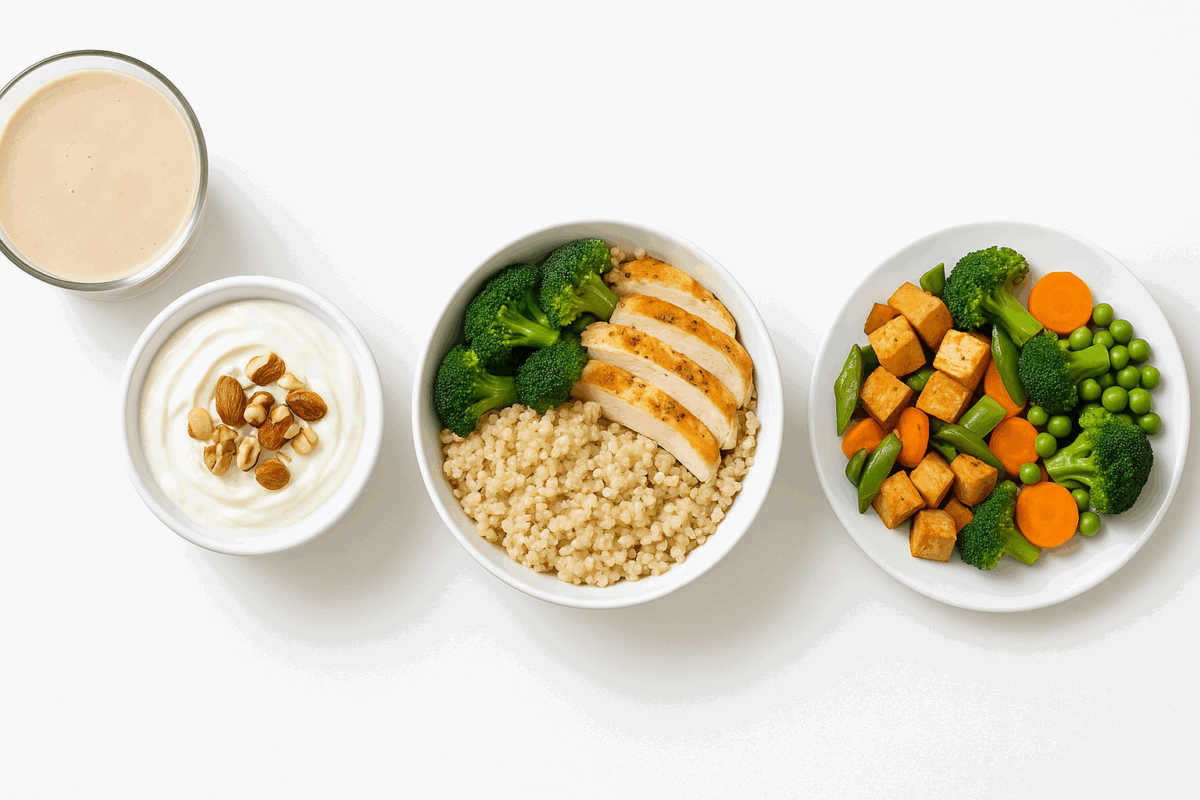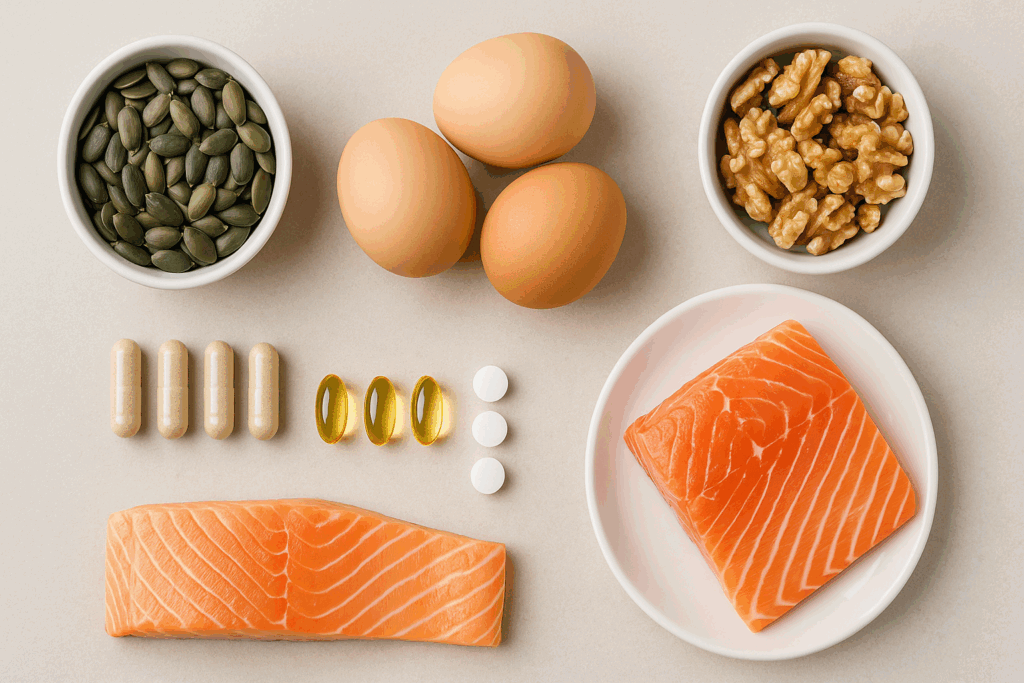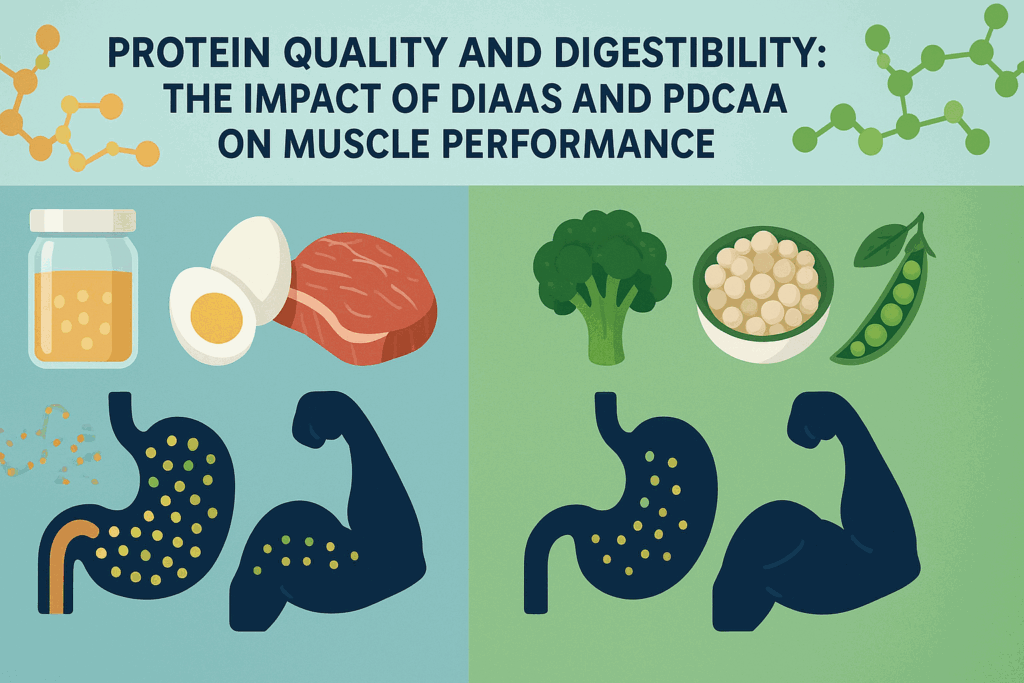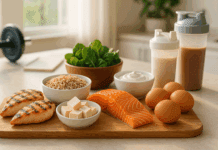Building strength is about more than just lifting heavier weights or pushing through intense gym sessions. It requires a thoughtful and strategic approach that fuses both fitness and nutrition. For individuals committed to maximizing their physical potential, understanding how to integrate high-protein dietary habits with scientifically backed exercise methods is essential. In this guide, we explore how to optimize strength development through a seamless synergy of fitness and nutrition, supported by cutting-edge research and real-world application.
You may also like : The Ultimate Guide to Choosing a High Protein Diet Name That Fits Your Goals

Why Strength Matters: The Biological and Functional Benefits of Power Training
Strength is a foundational attribute that underpins nearly every physical activity. From basic movements like standing up from a chair to more complex feats like sprinting or climbing stairs, muscular strength is essential for performance, injury prevention, and longevity. Research consistently shows that individuals with greater strength have reduced risks of falls, fractures, and metabolic diseases. Furthermore, strength correlates positively with bone density, joint health, and even cognitive function.
The benefits of strength go beyond aesthetics or athleticism. A robust muscular system contributes to improved posture, better hormone regulation, and enhanced insulin sensitivity. In older populations, strength training is one of the few interventions proven to delay or even reverse sarcopenia, the age-related loss of muscle mass and strength. As such, building and maintaining muscle through a high-protein diet and fitness strategy is an investment in both short-term vitality and long-term health resilience.

The Science of Muscle Growth: How Resistance Stimuli and Protein Synthesis Interact
To understand how to build strength effectively, one must first grasp the fundamental processes behind muscle growth. Resistance training causes microtrauma to muscle fibers, triggering a cascade of cellular responses aimed at repairing and reinforcing the tissue. This adaptation process, known as hypertrophy, depends on a sufficient supply of amino acids—the building blocks of protein—to support tissue regeneration.
Muscle protein synthesis (MPS) is the key driver of muscle repair and growth. Following resistance exercise, MPS rates increase, but the presence of dietary protein is essential to sustain this process. Without adequate protein intake, the body cannot fully capitalize on the anabolic window—the critical period post-workout where muscle growth potential peaks. Timing, quantity, and quality of protein all influence the efficiency of MPS and, by extension, the gains in strength and muscle mass.
Fitness and Nutrition: Building Strength through Synergistic Training and Diet Protocols
True strength enhancement occurs when training and diet align with precision. Fitness and nutrition strategies must support each other to create an environment conducive to muscle repair, growth, and performance enhancement. One common mistake among gym-goers is to focus solely on training while neglecting dietary components. Without adequate fuel, even the best-designed workout plans will fall short.
To optimize results, individuals should synchronize resistance training routines with high-protein meals that deliver at least 20–40 grams of protein post-exercise. Incorporating complete protein sources—such as lean meats, dairy, eggs, and plant-based combinations like rice and beans—ensures the full range of essential amino acids is available. Additionally, nutrient timing matters. Consuming protein within 60 minutes after training maximizes MPS and accelerates recovery.
Carbohydrates also play a pivotal role by replenishing glycogen stores and stimulating insulin release, which enhances amino acid uptake in muscle tissue. Thus, an integrated approach to fitness and nutrition considers not just macronutrient amounts but their timing and interplay as well.

Designing a High-Protein Diet for Strength: Practical Meal Planning and Macronutrient Ratios
A well-structured high-protein diet provides the essential substrates for muscle repair and growth while also supporting energy needs. For strength athletes or fitness enthusiasts, daily protein intake should range between 1.6 and 2.2 grams per kilogram of body weight. This target ensures a continuous supply of amino acids to fuel MPS throughout the day.
Meal composition matters. Each meal should ideally contain 25–40 grams of high-quality protein distributed evenly across breakfast, lunch, dinner, and snacks. Examples include Greek yogurt with nuts, chicken breast with quinoa, tofu stir-fry, or protein shakes with oats. Pairing proteins with fiber-rich vegetables, healthy fats, and complex carbohydrates enhances nutrient absorption and overall metabolic health.
Hydration also plays an underrated yet vital role. Water supports enzymatic activity involved in digestion and metabolism, and staying hydrated ensures optimal muscle contraction and nutrient transport. Caffeine, in moderate amounts, can enhance workout performance and increase pain tolerance during heavy lifting. However, excessive intake may impair sleep, which is critical for recovery and muscle growth.
Inflammation and Recovery: Managing Muscle Stress with Protein and Antioxidants
Building strength requires pushing the body beyond its comfort zone, which naturally induces inflammation and micro-tears in muscle fibers. While this is a necessary part of the adaptation process, unchecked or chronic inflammation can impair recovery and increase injury risk. High-protein diets help buffer this effect by supporting tissue repair, but when paired with antioxidant-rich foods, the recovery process becomes even more efficient.
Nutrients such as vitamin C, E, and polyphenols from berries, leafy greens, and spices like turmeric reduce oxidative stress and support mitochondrial health. This synergizes with amino acids like glutamine and arginine, which aid in muscle cell regeneration and immune function. By managing inflammation through both fitness and nutrition, athletes can reduce downtime between workouts and maintain a higher training frequency—an essential factor in building long-term strength.
Moreover, emerging research highlights the benefit of omega-3 fatty acids in reducing exercise-induced muscle damage and improving the anabolic response to protein. Incorporating wild-caught salmon, chia seeds, or algae-based supplements into a high-protein meal plan offers a powerful combination for strength, repair, and metabolic resilience.

Psychological Resilience and Strength: The Neurobiological Impact of Protein Intake
Strength isn’t only physical—it’s also mental. Recent investigations into the gut-brain-muscle axis reveal that protein intake can influence neurotransmitter balance and psychological resilience. Amino acids like tryptophan and tyrosine serve as precursors to serotonin and dopamine, respectively—neurochemicals that modulate mood, motivation, and focus. A well-balanced, high-protein diet supports cognitive stamina during long workouts and reduces mental fatigue during stressful training periods.
This connection between diet and fitness outcomes extends into sleep as well. Sufficient protein intake, particularly when spaced throughout the day, supports the production of melatonin and growth hormone during sleep—two factors crucial to both mental recovery and muscle growth. Casein protein before bed, known for its slow digestion rate, is particularly effective in this regard, helping improve overnight muscle protein synthesis while enhancing sleep quality.
In practical terms, those looking to boost both physical and mental strength should not overlook the cognitive side of protein nutrition. Addressing brain chemistry through food can unlock not only better workouts but also more consistent habits, sharper focus, and reduced stress reactivity—all critical for sustained fitness and nutrition progress.
Fitness and Nutrition Approaches for Maximizing Hypertrophy and Functional Strength
Not all strength is created equal. Functional strength focuses on movements that enhance real-world performance, while hypertrophy emphasizes muscle size. Fortunately, the two are not mutually exclusive. Effective programs blend elements of both by varying intensity, volume, and movement patterns.
Compound exercises such as squats, deadlifts, bench presses, and rows stimulate large muscle groups and activate multiple joints simultaneously, making them ideal for functional and aesthetic development. Training should follow the principle of progressive overload, where resistance or training volume increases consistently over time.
To support this, a high-protein nutritional plan provides the recovery capacity needed to tolerate increasing loads. Eating a small protein-rich meal before bed—such as cottage cheese or a casein shake—can reduce overnight catabolism and support overnight MPS. Creatine monohydrate, beta-alanine, and branched-chain amino acids (BCAAs) are well-researched supplements that can enhance performance and recovery when integrated into a consistent diet and exercise plan.

The Role of Micronutrients and Supplementation in Strength Optimization
While protein receives much attention, micronutrients should not be overlooked in any comprehensive fitness and nutrition program. Magnesium, zinc, iron, and B vitamins are essential for energy production, oxygen transport, and neuromuscular function. Deficiencies in these nutrients can impair muscle performance, slow recovery, and increase injury risk.
Vitamin D plays a particularly important role in muscle function and bone integrity. Low vitamin D levels are associated with reduced strength, increased fatigue, and compromised immune function. Sunlight exposure, fortified foods, and supplementation help maintain adequate levels, especially in individuals who train indoors or live in northern climates.
Omega-3 fatty acids from sources like fish oil reduce inflammation and support joint health. This is especially important for lifters engaging in high-intensity routines that can stress connective tissue. Additionally, adaptogenic herbs such as ashwagandha may help modulate cortisol levels, improving stress resilience and supporting muscle recovery.
Hormonal Synergy: How High-Protein Diets Influence Testosterone, IGF-1, and Cortisol
Another critical lens through which to view strength development is endocrine health. Fitness and nutrition together modulate key anabolic and catabolic hormones that dictate muscle growth, fat loss, and performance adaptation. Testosterone and insulin-like growth factor 1 (IGF-1) are two major anabolic hormones that promote muscle repair and increase protein synthesis. On the flip side, cortisol—while necessary in acute bouts—can be catabolic when chronically elevated, breaking down muscle and inhibiting recovery.
High-protein diets, particularly when paired with adequate caloric intake and resistance training, support healthy testosterone levels and enhance the body’s sensitivity to IGF-1. In contrast, low-protein or excessively high-carb diets, especially when combined with overtraining or poor sleep, can suppress these critical anabolic pathways and elevate cortisol chronically.
It’s important to note that the balance of macronutrients matters. While protein is the central pillar, sufficient dietary fat is essential for maintaining testosterone synthesis, as cholesterol is a precursor to steroid hormones. Including quality fats—like omega-3s, monounsaturated fats from olive oil, and fat from grass-fed meats—alongside high-protein meals ensures a supportive hormonal environment for strength gains.
The Role of Periodization in Fitness and Nutrition for Long-Term Strength Gains
Many people mistakenly view strength development as a linear process—more protein, heavier weights, and consistent progress. But the reality is more complex. Just as training programs use periodization (planned variations in volume, intensity, and rest) to maximize performance, nutritional strategies benefit from periodized approaches as well. This concept, known as “diet periodization,” involves adjusting protein intake, caloric levels, and macronutrient distribution in alignment with training cycles.
During hypertrophy-focused phases, slightly higher carbohydrate and calorie intake supports increased training volume and glycogen replenishment. Protein remains high, typically around 1.6 to 2.2 grams per kilogram of body weight, but fat intake may be slightly reduced to prioritize energy availability from carbs. In contrast, strength or power phases may benefit from a modest protein increase and reduced carbs to emphasize neuromuscular adaptation over pure mass.
Additionally, during deloads or active rest periods, protein needs remain high to preserve muscle tissue, but overall caloric intake can be adjusted downward to avoid unnecessary fat gain. This tailored approach creates a sustainable, goal-specific model of fitness and nutrition that evolves with the athlete’s body and training cycle—rather than relying on a one-size-fits-all model.
Tracking Progress and Adjusting Diet and Exercise Plans Over Time
Strength development is not a linear journey. Plateaus are inevitable, and progress requires periodic reassessment and adjustment. Tracking variables such as training volume, rest intervals, sleep quality, and nutritional intake enables individuals to identify limiting factors and refine their approach.
Body composition analysis, strength testing, and performance metrics provide tangible data to inform changes. For instance, if progress stalls despite consistent training, increasing protein intake or adjusting caloric surplus may reignite gains. Conversely, during cutting phases, preserving lean mass requires meticulous attention to protein timing and overall intake.
Flexibility and consistency are both crucial. Adherence to a high-protein diet and fitness routine over time matters more than perfection. Strategic deloading weeks, active recovery sessions, and variety in training stimuli help prevent overtraining and maintain motivation.
Fitness and Nutrition Strategies to Sustain Strength Through Aging
Strength is often thought of as the domain of youth, but with the right fitness and nutrition practices, it can be preserved well into older adulthood. Muscle mass naturally declines with age, but resistance training combined with a high-protein diet can mitigate these effects. Older adults may require even higher protein intakes due to anabolic resistance, a reduced sensitivity to dietary protein.
Furthermore, balance and flexibility become increasingly important. Functional training that includes movements mimicking daily activities enhances mobility and reduces fall risk. Exercises such as step-ups, farmer’s carries, and resistance band routines provide low-impact ways to build and maintain muscle.
Nutrition for older adults should emphasize protein density, easily digestible meals, and adequate hydration. Supplementation with vitamin D, calcium, and omega-3 fatty acids becomes even more critical for bone and joint support. The goal is to build a foundation of strength that supports independence, resilience, and quality of life.

Protein Quality and Digestibility: The Impact of DIAAS and PDCAAS on Muscle Performance
While most people understand the importance of eating protein, fewer are aware of how protein quality affects muscle strength. Two key scientific metrics help clarify this: the Digestible Indispensable Amino Acid Score (DIAAS) and the Protein Digestibility Corrected Amino Acid Score (PDCAAS). These scores evaluate the biological quality of protein based on its amino acid composition and digestibility. DIAAS is the more recent and precise measure, showing which protein sources are most effective for human nutrition and strength enhancement.
Animal-based proteins like dairy, eggs, and lean meats consistently score higher on both DIAAS and PDCAAS due to their complete amino acid profiles and high digestibility. Plant-based proteins, while health-promoting in other ways, often score lower unless properly combined to achieve amino acid balance. For vegetarians and vegans seeking to optimize fitness and nutrition, combining legumes with grains (like lentils and rice or hummus and whole-grain pita) can mimic the effects of complete protein intake.
Using DIAAS as a guiding metric allows for a more intelligent approach to meal planning. Athletes who pay attention to protein quality rather than quantity alone are better positioned to enhance muscle strength, reduce training-related fatigue, and accelerate recovery without overconsuming calories.
Using Fitness and Nutrition to Support Recovery and Prevent Injury
Recovery is an often underestimated pillar of strength development. Without proper recovery, training becomes counterproductive, increasing the risk of injury and burnout. Fitness and nutrition must work hand-in-hand to promote healing and restore performance capacity.
Sleep is arguably the most powerful recovery tool. It regulates hormonal function, repairs muscle tissue, and consolidates neuromuscular adaptations. Nutrition supports this by supplying substrates like tryptophan and magnesium, which enhance sleep quality.
Anti-inflammatory foods such as berries, leafy greens, turmeric, and fatty fish contribute to muscle repair and reduce delayed onset muscle soreness (DOMS). Post-workout meals should include both protein and carbohydrates to replenish glycogen and jumpstart recovery. Hydration with electrolytes ensures optimal cellular function and reduces cramping.
Cross-training and mobility work, such as yoga or foam rolling, improve circulation and joint function, complementing strength-focused routines. When integrated thoughtfully, these strategies make fitness and nutrition a comprehensive recovery system.
Gut Health and Protein Absorption: The Overlooked Link in Strength Optimization
The fitness and nutrition relationship isn’t only about what you eat—it’s also about what your body can absorb and utilize. Recent studies underscore the critical role of gut health in protein metabolism and nutrient absorption. A compromised gut microbiome, characterized by dysbiosis or chronic inflammation, can hinder amino acid absorption and blunt the anabolic response to protein intake. This is particularly relevant for those undergoing intense physical training, which itself places stress on the gut lining and immune system.
Probiotics, fermented foods, and prebiotic fibers can enhance protein assimilation by improving gut permeability and microbial diversity. This, in turn, ensures that high-protein diets actually deliver their intended performance benefits. Athletes experiencing digestive issues or persistent fatigue may benefit from integrating a gut-health strategy alongside their strength program—emphasizing fermented vegetables, kefir, or targeted probiotic strains that support proteolytic bacteria.
Moreover, research now shows that certain gut bacteria metabolize amino acids into bioactive compounds that influence muscle protein synthesis, systemic inflammation, and even hormone regulation. Thus, optimizing the gut microbiome adds another powerful layer to fitness and nutrition synergy, helping turn dietary inputs into real performance outputs.
Integrating Fitness and Nutrition into a Sustainable Lifestyle
Sustainability is the ultimate test of any fitness and nutrition strategy. Fad diets and extreme routines may yield short-term results, but they often lead to burnout or regression. The key lies in creating habits that align with personal values, lifestyle constraints, and long-term goals.
Meal prepping, mindful eating, and periodic indulgences contribute to dietary adherence without sacrificing enjoyment. Likewise, workouts should be challenging yet enjoyable, incorporating activities that align with individual interests. Whether it’s powerlifting, bodyweight circuits, or high-intensity interval training (HIIT), the best fitness routine is one that can be maintained consistently.
Education empowers autonomy. Understanding how macronutrients influence performance, how training variables affect adaptation, and how to self-assess progress allows individuals to become self-sufficient in their fitness journey. Communities, whether online or in-person, offer accountability and motivation, reinforcing positive behaviors.
Ultimately, strength is not just a physical attribute but a reflection of discipline, strategy, and resilience. By embracing a lifestyle rooted in high-protein fitness and nutrition, individuals can unlock their full potential, sustain health across the lifespan, and experience the empowerment that comes from mastering their body and habits.
Frequently Asked Questions (FAQ): Exploring Advanced Strategies and Insights into Fitness and Nutrition
1. How does psychological resilience influence long-term success with fitness and nutrition?
Psychological resilience plays a critical yet often overlooked role in maintaining consistent habits in fitness and nutrition. Individuals with higher resilience are more likely to overcome setbacks such as injury, plateaus, or emotional eating triggers. These individuals often develop a growth mindset, viewing failures as learning opportunities instead of reasons to quit. Moreover, resilient people tend to structure their diet and fitness routines to accommodate life stressors, making them more sustainable in the long run. Cultivating resilience through mindfulness, journaling, or cognitive behavioral strategies can profoundly enhance one’s commitment to diet and exercise, ensuring a more adaptive, lasting transformation.
2. What is metabolic flexibility, and why is it a game-changer in diet and fitness planning?
Metabolic flexibility refers to the body’s ability to efficiently switch between burning carbohydrates and fats for fuel. This adaptation becomes especially important in optimizing fitness and nutrition outcomes, as it enables individuals to perform well in both endurance and high-intensity workouts while also managing weight more effectively. Athletes and health-conscious individuals who cycle between low- and high-carb days or engage in intermittent fasting often exhibit improved metabolic flexibility. Additionally, training the body to become metabolically flexible may improve insulin sensitivity and reduce inflammation. Implementing varied macronutrient profiles in your diet and aligning them with your training days can enhance metabolic adaptability and performance.
3. How do social dynamics impact one’s commitment to a fitness and nutrition plan?
Social dynamics exert a profound influence on long-term adherence to fitness and nutrition goals. Supportive environments—whether through friends, family, or fitness communities—can boost motivation and accountability. Conversely, social pressure or a lack of understanding from peers can derail progress. Studies show that individuals who join group fitness programs or engage in shared meal prep are significantly more likely to maintain lifestyle changes. Social support also fosters a sense of belonging, which can mitigate the feelings of isolation that sometimes accompany strict diet and exercise regimens. Building a network aligned with your health priorities creates a fertile ground for lasting change in both diet and fitness habits.
4. What role does micronutrient timing play in enhancing physical performance?
While macronutrient timing often dominates discussions, micronutrient timing is gaining traction for its nuanced role in performance and recovery. For instance, consuming magnesium and vitamin D in the evening may aid muscle relaxation and improve sleep quality, both vital for muscle repair. Antioxidants such as vitamin C and E taken post-workout can combat oxidative stress but may also blunt training adaptations if used excessively. Therefore, understanding when and how to supplement can make or break a fitness and nutrition program. Consulting with a dietitian to strategically align micronutrient intake with your exercise regimen allows for tailored, evidence-based optimization.
5. Can advances in wearable technology help personalize diet and fitness strategies?
Absolutely. Modern wearable tech now offers real-time data on heart rate variability, sleep patterns, blood glucose, and even hydration levels—transforming the way individuals tailor their fitness and nutrition plans. Devices like continuous glucose monitors (CGMs) reveal how different foods impact your unique metabolism, allowing more precise diet adjustments. Additionally, AI-driven fitness trackers analyze movement efficiency, suggesting optimized workout regimens. This data-centric approach empowers users to shift from generalized advice to individualized strategies, leading to better adherence and faster results. By integrating tech insights into diet and exercise plans, individuals can unlock a deeper, more accurate level of health personalization.
6. How can travel and frequent schedule changes be managed without derailing diet and exercise goals?
Travel, shift work, or erratic schedules can disrupt even the most consistent fitness and nutrition plans, but strategic planning can mitigate this. Portable workout tools like resistance bands or bodyweight routines make it possible to maintain physical activity anywhere. Similarly, prepping nutrient-dense, shelf-stable meals or identifying healthy restaurant options in advance helps uphold dietary integrity. Travelers can also time workouts to align with circadian rhythm adjustments, reducing jet lag and supporting immune function. The key is flexibility—adapting rather than abandoning routines. Diet and fitness should be seen as a lifestyle, not a rigid program, especially when navigating real-world variables.
7. How does gut health intersect with fitness and nutrition optimization?
The gut microbiome is emerging as a central player in determining the effectiveness of diet and exercise interventions. A balanced microbiota enhances nutrient absorption, supports immune function, and even influences muscle recovery and mental clarity. Prebiotic and probiotic foods—such as fermented vegetables, kefir, and resistant starches—can improve gut diversity, leading to better metabolic outcomes. Interestingly, exercise itself positively alters gut flora, creating a feedback loop that enhances both physical and digestive health. Recognizing this connection allows individuals to integrate gut-supportive strategies into their fitness and nutrition plans for more comprehensive, synergistic results.
8. How can long-term adherence to diet and fitness routines be psychologically supported?
Sustainability in fitness and nutrition is deeply psychological. Strategies like intrinsic goal setting—focusing on internal rewards such as energy levels or mental clarity—are more effective than extrinsic goals like weight loss alone. Visualization techniques, habit stacking, and motivational interviewing are also powerful tools in behavioral psychology that enhance adherence. Apps that gamify progress can reinforce positive behavior, especially when integrated with community-based support. Ultimately, treating diet and exercise as evolving habits rather than static obligations fosters identity shifts that anchor long-term success. Behavioral reinforcement, not willpower alone, is the cornerstone of lifestyle permanence.
9. Why is sleep a critical pillar often neglected in discussions about fitness and nutrition?
Sleep acts as the unsung hero in the triad of health alongside fitness and nutrition. Inadequate sleep impairs glucose metabolism, increases cortisol, and diminishes recovery—all of which sabotage progress in both diet and exercise. Moreover, sleep deprivation alters hunger hormones like leptin and ghrelin, leading to poor food choices and cravings. Athletic performance also suffers, as reaction times, endurance, and strength metrics all decline with sleep debt. Incorporating consistent sleep hygiene practices—such as limiting blue light exposure and establishing a bedtime routine—should be as prioritized as macros or reps. High-performance living demands high-quality rest.
10. What future trends could redefine the landscape of fitness and nutrition?
Emerging trends such as DNA-based meal and workout plans, AI-driven coaching, and precision supplementation are poised to revolutionize how we approach fitness and nutrition. Nutrigenomics allows practitioners to design diets tailored to genetic predispositions, reducing trial-and-error in food choices. Similarly, machine learning platforms can synthesize biometric data to fine-tune training loads and recovery protocols. There’s also increasing interest in plant-based performance diets, adaptive fasting protocols, and digital therapeutics for mental resilience. These innovations underscore a shift from generic programs to hyper-personalized systems, where science meets individual experience for unmatched results in diet and fitness transformations.
Conclusion: Uniting Strength, Longevity, and Vitality through High-Protein Fitness and Nutrition Strategies
Achieving and maintaining strength is not the result of a single factor but the convergence of deliberate fitness and nutrition choices applied consistently over time. High-protein diets serve as the biochemical foundation for muscle development, repair, and function, while structured resistance training activates the mechanical pathways that drive hypertrophy and strength adaptation. When these elements coalesce, they create a synergy that empowers individuals to surpass their goals and elevate their quality of life.
This guide has explored the biological underpinnings, practical applications, and long-term strategies for integrating fitness and nutrition to build lasting strength. From understanding the science of protein synthesis to leveraging meal timing and micronutrient support, every detail matters in crafting a comprehensive approach. By emphasizing sustainability, individualized planning, and evidence-based practices, we foster not only physical resilience but also mental fortitude and lifestyle alignment.
In a world where quick fixes often overshadow true solutions, returning to the fundamentals of diet and exercise—anchored in the proven power of fitness and nutrition—offers a transformative path forward. With knowledge, intention, and commitment, strength becomes more than a goal; it becomes a way of life.
Further Reading:
The Balance Between Nutrition and Fitness
Physical fitness and nutrition: Know your terms
The Best Diet for Fitness Training: The Facts You Need to Know





